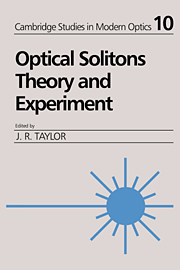Book contents
- Frontmatter
- Contents
- List of contributors
- Preface
- 1 Optical solitons in fibers: theoretical review
- 2 Solitons in optical fibers: an experimental account
- 3 All-optical long-distance soliton-based transmission systems
- 4 Non-linear propagation effects in optical fibres: numerical studies
- 5 Soliton–soliton interactions
- 6 Soliton amplification in erbium-doped fiber amplifiers and its application to soliton communication
- 7 Non-linear transformation of laser radiation and generation of Raman solitons in optical fibers
- 8 Generation and compression of femtosecond solitons in optical fibers
- 9 Optical fiber solitons in the presence of higher-order dispersion and birefringence
- 10 Dark optical solitons
- 11 Soliton-Raman effects
- Index
2 - Solitons in optical fibers: an experimental account
Published online by Cambridge University Press: 21 October 2009
- Frontmatter
- Contents
- List of contributors
- Preface
- 1 Optical solitons in fibers: theoretical review
- 2 Solitons in optical fibers: an experimental account
- 3 All-optical long-distance soliton-based transmission systems
- 4 Non-linear propagation effects in optical fibres: numerical studies
- 5 Soliton–soliton interactions
- 6 Soliton amplification in erbium-doped fiber amplifiers and its application to soliton communication
- 7 Non-linear transformation of laser radiation and generation of Raman solitons in optical fibers
- 8 Generation and compression of femtosecond solitons in optical fibers
- 9 Optical fiber solitons in the presence of higher-order dispersion and birefringence
- 10 Dark optical solitons
- 11 Soliton-Raman effects
- Index
Summary
Introduction
In optical fibers, solitons are non-dispersive light pulses based on non-linearity of the fiber's refractive index. Such fiber solitons have already found exciting use in the precisely controlled generation of ultrashort pulses, and they promise to revolutionise telecommunications. In this chapter, I shall describe those developments, and the experimental studies they have stimulated or have helped to make possible. Thus, besides the first experimental observation of fiber solitons, I shall describe the invention of the soliton laser, the discovery of a steady down-shift in the optical frequency of the soliton, or the ‘soliton self-frequency shift’, and the experimental study of interaction forces between solitons.
As early as 1973, Hasegawa and Tappert (1973) pointed out that ‘single-mode’ fibers – fibers admitting only one transverse variation in the light fields – should be able to support stable solitons. Such fibers eliminate the problems of transverse instability and multiple group velocities from the outset, and their non-linear and dispersive characteristics are stable and well-defined. The first experiments (Mollenauer et al., 1980), however, had to wait a while, for two key developments of the late 1970s. The first was fibers having low loss in the wavelength region where solitons are possible, and the second was a suitable source of picosecond pulses, the mode-locked color center laser.
But the first experiments led almost immediately to further developments.
- Type
- Chapter
- Information
- Optical SolitonsTheory and Experiment, pp. 30 - 60Publisher: Cambridge University PressPrint publication year: 1992
- 4
- Cited by



